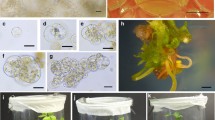Summary
In Solanum tuberosum the production by parthenogenesis of 2x plants with 24 chromosomes, and the regeneration of microspores of such dihaploids to yield monohaploid (1x) plants is reproducibly possible, at least for some specific genotypes. Experiments are described using tissue culture techniques in an applied breeding program with the main aim of increasing the level of resistance to the potato cyst nematode Globodera pallida (Stone) and to the potato viruses X, Y and leaf roll. These resistances follow quantitative as well as qualitative modes of inheritance. Using anther culture it is demonstrated that doubled monohaploid clones can be produced which possess the resistance in the homozygous condition. In both ways of inheritance the ratio of resistant clones is rather high. The genotype of the anther donor plant has, however, a strong influence on the total number of androgenetic plants which can be regenerated. Therefore, experiments were initiated with the aim of integrating this capacity for regeneration (tissue culture ability) into valuable genotypes. The results show that the potentiality for regeneration is under genetic control and can be utilized by combination breeding. Its inheritance and physiological basis, as well as the behaviour of complete homozygous clones, is discussed.
Similar content being viewed by others
Literature
Behnke, M. (1979): Selection of potato callus for resistance to culture filtrates of Phytophthora infestans and regeneration of resistant plants. Theor. Appl. Genet. 55, 69–71
Behnke, M. (1980): General resistance to late blight of Solanum tuberosum plants regenerated from callus resistant to culture filtrates of Phytophthora infestans. Theor. Appl. Genet. 56, 151–152
Behringer, P. (1967): Der Biotest-Nematodennachweis mit Zukunft. Kartoffelbau 18, 170–172
Breukelen, E.W. van; Ramanna, M.S.; Hermsen, J.G.Th. (1975): Monohaploids (n=x=12) from autotetraploid solanum tuberosum (2n=4x=48) through two successive cycles of female parthenogenesis. Euphytica 24, 567–574
Hermsen, J.G.Th.; Verdenius, J. (1973): Selection from Solanum tuberosum group phureja of genotypes combining high frequency haploid induction with homozygosity for embryo spot. Euphytica 22, 244–259
Jacobsen, E.; Sopory, S.K. (1978): the influence and possible recombination of genotypes on the production of microspore embryoids in anther cultures of Solanum tuberosum and dihaploid hybrids. Theor. Appl. Genet. 52, 119–123
Keyes, G.J.; Collins, G.B.; Taylor, N.L. (1980): Genetic variation in tissue culture of red clover. Theor. Appl. Genet. 58, 265–271
Kort, J.; Ross, H.; Rumpenhorst, H.J.; Stone, A.R. (1977): An international scheme for identifying and classifying pathotypes of potato cyst-nematodes Globodera rostochiensis and G. pallida Nematologica 23, 333–339
Murashige, T.; Skoog, F. (1962): A revised medium for rapid growth and bioassays with tobacco tissue culture. Physiol. Plant 15, 473–497
Paepe, de R.; Bleton, D.; Gnangbe, F. (1981): Basis and extent of genetic variability among doubled-haploid plants obtained by pollen culture in Nicotiana sylvestris. Theor. Appl. Genet. 59, 177–184
Picard, E. (1980): Some variations obtained in yields and behaviour of doubled haploid progenies from wheat cultivars. NSFCNRS Seminar on: Regeneration From Cells and Tissue Culture and Genetic Variability. Orsay (in press)
Ross, H. (1954): Die Vererbung der ‘Immunität gegen das X-Virus in tetraploidem S. acaule’. Caryologia 6 Suppl. Proc. 9. Intern. Confer. Genetics, Bellagio
Ross, H. (1958): Virusresistenzzüchtung an der Kartoffel. Eur. Pot. J. 1, 1–19
Simon, P.W.; Peloquin, S.J. (1977): The influence of parental species on the origin of callus in anther cultures of Solanum hybrids. Theor. Appl. Genet. 50, 53–56
Sopory, S.K. (1977): Development of embryoids in isolated pollen culture of dihaploid Solanum tuberosum. Z. Pflanzenphysiol. 84, 453–457
Sopory, S.K.; Jacobsen, E.; Wenzel, G. (1978): Production of monohaploid embryoids and plantlets in cultured anthers of Solanum tuberosum. Plant Sci. Lett. 12, 47–54
Uhrig, H. (1981): Regeneration of protoplasts of dihaploid potato plants bleached by an environmental factor. Molec. Gen. Genet. (in press).
Uhrig, H.; Wenzel, G. (1981): Solanum gourlayi Hawkes as a source of resistance against the white cyst nematode Globodera pallida Stone. Z. Pflanzenzücht. 86, 148–157
Wenzel, G. (1971): Vergleichende Untersuchung des Interferenzverhaltens phytopathogener Viren auf Tabak. Phytopath. Z. 71, 147–162
Wenzel, G. (1979): Neue Wege in der Kartoffelzüchtung I. Vom Sortenklon zu Haploiden. Kartoffelbau 30, 126–129
Wenzel, G.; Hoffmann, F.; Potrykus, I.; Thomas, E. (1975): The separation of viable rye microspores from mixed populations and their development in culture. Molec. Gen. Genet. 138, 293–297
Wenzel, G.; Meyer, C.; Przewozny, T.; Uhrig, H.; Schieder, O. (1980): Incorporation of microspore and protoplast techniques into potato breeding programs. NSF-CNRS Seminar on: Regeneration from cells and tissue culture and genetic variability. Orsay (in press)
Wenzel, G.; Schieder, O.; Przewozny, T.; Sopory, S.K.; Melchers, G. (1979): Comparison of single cell culture derived Solanum tuberosum L. plants and a model for their application in breeding programs. Theor. Appl. Genet. 55, 49–55
Wernicke, W.; Harms, C.T.; Lörz, H.; Thomas, E. (1978): Selective enrichment of embryogenic microspore populations. Naturwissenschaften 65, 540–541
Author information
Authors and Affiliations
Additional information
Communicated by G. Melchers
Dedicated to Prof. Dr. Joseph Straub on the occasion of his 70. birthday
Rights and permissions
About this article
Cite this article
Wenzel, G., Uhrig, H. Breeding for nematode and virus resistance in potato via anther culture. Theoret. Appl. Genetics 59, 333–340 (1981). https://doi.org/10.1007/BF00276445
Received:
Issue Date:
DOI: https://doi.org/10.1007/BF00276445




